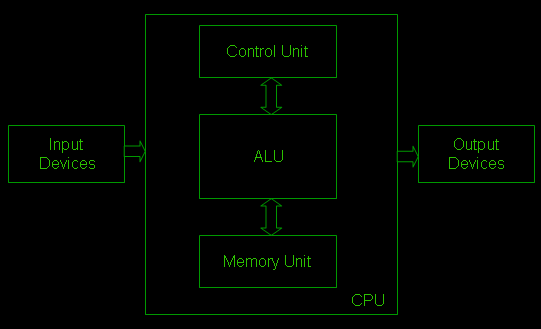
CPU (Central Processing Unit)
Description
- It's a microprocessor chip developed by Intel, AMD or any other company.
- CPU speed depends upon the clock frequency, higher the clock frequency more number of instructions can be executed per second.
- Clock frequency is measured in MHz or GHz.
- CPU word size is the largest number of bits that can be handled by CPU in one clock cycle. It is either 8, 16, 32, 64 or 128 bit.
- This word size value determines number of bit processor i.e. 8-bit processor, 16-bit processor, 32 bit processor etc.
- CPU performance also depends upon the RAM, bus speed and cache size as well.
- Called as heart of the computer.
Block diagram

Working:
- CPU consists of three basic units: control unit, Arithmetic Logical Unit (ALU) and memory unit.
- Input is given through the input devices to CPU.
- Control unit controls communication within ALU and memory unit.
- Decides which circuit is to be activated.
- For reading instruction it uses Fetch-execute mechanism.
- Control unit gets instruction from memory.
- Control unit decides what to do of that instruction and transfers it to the ALU.
- ALU performs various arithmetic operations like addition, subtraction, multiplication, division and logical operations like AND, OR, NOT, NAND etc. on that instruction.
- Results of ALU are stored in the memory or resistor for its further operations.
- After completing the instruction, stored results are passed to the output devices.
- To synchronize all these operations CPU uses its own system clock.
What it does?
- Executes stored instructions called as program.
- Tells rest of the computer system what to do.
- Executes arithmetic calculation and data manipulation.
- Holds data and instruction which are in the current use.
- Responsible for storing and retrieving information on disks and other media.
Tip Box
|
All CPU’s have different numbers of pins at the bottom side, which can be easily bend or broken while installing onto the motherboard, so it must be done carefully. |
Advertisement
Terms of Use | Privacy Policy | Contact Us | Advertise
CodesandTutorials © 2014 All Rights Reserved